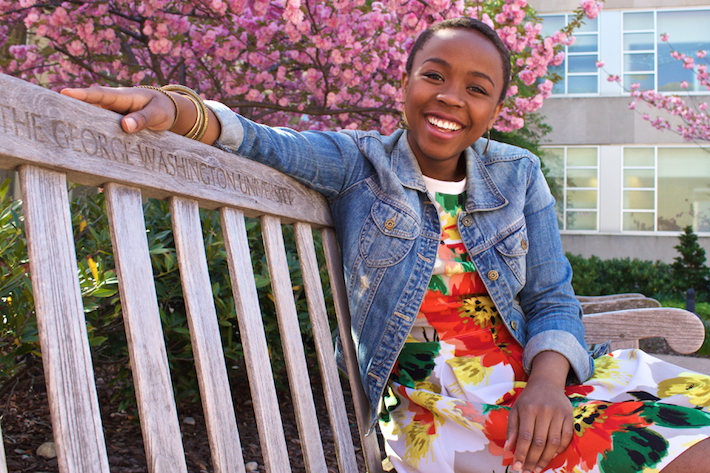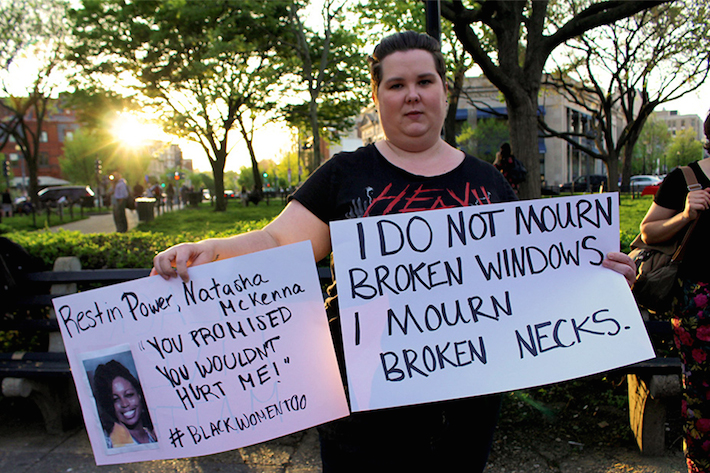From her resident advisor room in Mitchell Hall, Zinhle Essamuah, B.A. '15, could hear the chants of “Hands up, don’t shoot” echoing in the streets. It was November, and a grand jury had just decided against indicting a Ferguson, Mo., police officer in the shooting death of Michael Brown.
Ms. Essamuah quietly observed the meteoric resurgence of the #BlackLivesMatter hashtag, and watched as Facebook and Twitter erupted with reactions. Everyone had an opinion, it seemed, and the Internet gave voice to her peers.
Through all the social media posts, a single question nagged at Ms. Essamuah: How was the community in Ferguson feeling in the wake of such controversy?
A senior in the School of Media and Public Affairs at the time, Ms. Essamuah already had developed an impressive portfolio as a storyteller and documentarian. She wrote a stirring monologue that premiered last October in the Arena Stage production of “Our War.” She also contributed video shorts about sustainability and environmental protection to SMPA’s Planet Forward initiative and interned for CNN’s The Situation Room with Wolf Blitzer. She wanted to shed light on the stories of people in Ferguson and the unfolding Black Lives Matter movement. So, she applied to SMPA’s Manheim-Sterling Undergraduate Research Prizes, awarded annually to two students.

Zinhle Essamuah is now pursuing her master's degree as a Presidential Administrative Fellow. Photo by Milan Gary, B.A. '16.
“I was inspired to pursue the prize after I saw so many viewpoints from my peers exploding online—I didn’t know what to make of it. I wanted to further understand the profound impact Michael Brown’s death had on peoples’ lives,” she said.
Ms. Essamuah received the Manheim-Sterling grant in January 2015. She quickly went to work with her project adviser, Assistant Professor of Media and Public Affairs and faculty guide Imani Cheers.
Ms. Essamuah had previously taken an independent study course with Dr. Cheers, in which she examined the role of African and African American film and literature in social movements, specifically the South African apartheid. They were fascinated by the role of creative agency in film and understood the value of having a young black person document a movement predominantly led by young black people. They decided they had to get Ms. Essamuah to the epicenter of the protests.
A trip to Missouri became possible over spring break. Dr. Cheers arranged for Ms. Essamuah to stay with a student at Washington University and connected her to The Truth Telling Project, a weekend long event that convened protestors and community members in St. Louis. That’s where the idea for a film called “Hands Up” began to take shape.
Ms. Essamuah pulled on a pressed denim shirt and her thick-rimmed glasses and boarded a plane that landed in St. Louis the morning of March 12. The timing was a strange kind of alchemy: At the airport, she learned that two police officers had just been shot outside the Ferguson Police Department. The city was thick with intensity, and suddenly, Ms. Essamuah was right in the middle of it with a camera strapped securely around her neck.
She drove directly to the police headquarters. The location was mobbed with members of the press and camera operators—the swarms of media outnumbered protesters. Still, Ms. Essamuah and her assistant camera operator Josh Strupp, B.A. ’15, turned their lenses on any activists and community members who would talk to them.
The deeper the pair got into filming, the broader the story became. Interviews scheduled for 10 minutes evolved into two-hour conversations. She spoke to Philip Deitch, the founder of the U.S. Attorney’s Hate Crimes Taskforce in St. Louis, who has collected more than 60,000 photos and videos chronicling the history of the Ferguson community. She listened as 18-year-old activist Clifton Kinnie shared his frustration with media portrayals of his hometown. She interviewed clergy members who were among the first demonstrators arrested in Ferguson. She sat down with Brittany Packnett, a member of the Ferguson Commission and President Obama’s Taskforce for 21st Century Policing. Many of her interview subjects continued to make national headlines on outlets like MTV and CNN.
“I was learning that the things happening in Ferguson were not just a black America problem. This affected everyone, regardless of their age and their race,” she said.
Ms. Essamuah and Mr. Strupp worked into late hours of the night during four days of protests. As police activity heightened, they saw a few journalists get arrested and quickly learned their rights as filmmakers. A protestor scrawled the phone number of a lawyer on Ms. Essamuah’s arm—just in case. Ms. Essamuah said such communal protection was not uncommon among protestors, who appreciated the filmmakers’ commitment. Their stay in Ferguson allowed them to gain the trust of a number of community members.
“It was an interesting dynamic. As a student filmmaker and an African-American young person, the people there related to me differently. I went with the intention of sharing their story in the purest form. I had no intention of picking up just a sound bite, so they opened up to me,” Ms. Essamuah said.
She was composed during interviews, but reflective once they were finished. She wrote in her journal frequently during the trip and, upon her return to D.C., re-watched her video recordings and transcribed interviews, reliving her time with the people she’d met.
Almost one month later, Ms. Essamuah pored over the hours of footage she had compiled as she made final edits to the film. However, history had its own course for her project. News of Freddie Gray’s death in the custody of Baltimore police burst across media outlets, and suddenly the protests she had witnessed in Missouri were overtaking the very state where Ms. Essamuah, a Maryland native, had grown up.
Ms. Essamuah coincidentally had been attending the Baltimore Orioles game at Camden Yards that made headlines when demonstrations over Mr. Gray’s death heated up. Her time in Ferguson had trained her. She quickly observed an increased police presence, something few of her friends at the game had noticed. Peaceful protests became violent, and Ms. Essamuah and her peers left the stadium right before the park was placed on lockdown. As Maryland entered into a state of emergency in the following days, Ms. Essamuah did what she’d learned in Ferguson: She pulled out her camera and began recording.

Photo courtesy of Zinhle Essamuah.
“I thought, ‘I need to document this whole thing.’ To see the protests come home and watch military vans rolling down the streets was a surreal experience,” Ms. Essamuah said. “I went back and added the Baltimore element to my project to show that this is not something that ended in Ferguson. The story continues on and looks at what it means to live in America at a time when the Black Lives Matter movement is so rapidly unfolding.”
Post-production on “Hands Up” continued throughout this summer. Now, Ms. Essamuah’s 28-minute documentary is commanding attention throughout the country. It progressed to the semifinals of the national 42nd annual Student Academy Awards, putting it in the top 5 percent of all films submitted. “Hands Up” was accepted to the Urban Mediamakers Film Festival in Atlanta and is under consideration at a number of other festivals throughout the country.
Ms. Essamuah, now a Presidential Administrative Fellow pursuing her master’s in media and strategic communication, presented her work to the GW Board of Trustees in June. She also discussed the role of media in social justice on a panel hosted by the Global Women’s Institute, where is working as a fellow for the year. Ms. Essamuah hopes that beyond the big screen, this film will be used as a tool in classrooms at college and university levels. She is looking to partner with university professors, high school teachers and community leaders to incorporate “Hands Up” into course syllabi to spark healthy discussions about the movement. As issues regarding black lives remain at the forefront of national headlines, Ms. Essamuah continues to evaluate the structure of her story.
When “Hands Up” was still a work-in-progress last semester, Ms. Essamuah hosted a private screening at GW. Her two teenage brothers attended the event—something that was important to Ms. Essamuah because she had found herself thinking about them as she investigated the stories of violence against young people, specifically young black men. The film also sparked a conversation among the very peers whose tweets and Facebook posts had inspired her to start the project in the first place.
She was glad the film inspired dialogue, but she was also proud that it showcased the true community and deep bonds formed by those standing on the frontlines of the Black Lives Matter movement. Somehow, she found that themes of hope and support continually emerged out of her conversations with activists.
“To witness the love and experience deep connections in Ferguson, in many ways, made me more committed to the story. It wasn’t about the grant or the project. It was about the people, their hope—and continued struggle. It’s a story I had to share,” she said.
Stay up to date by following “Hands Up” on its website HandsUpDocumentary.com, on Facebook and Twitter and on Instagram at #HandsUpDoc. Keep up with Ms. Essamuah’s latest productions at simplyzinhle.com. Ms. Essamuah is raising money for the continued development and expansion of her project—you can support her work here.


